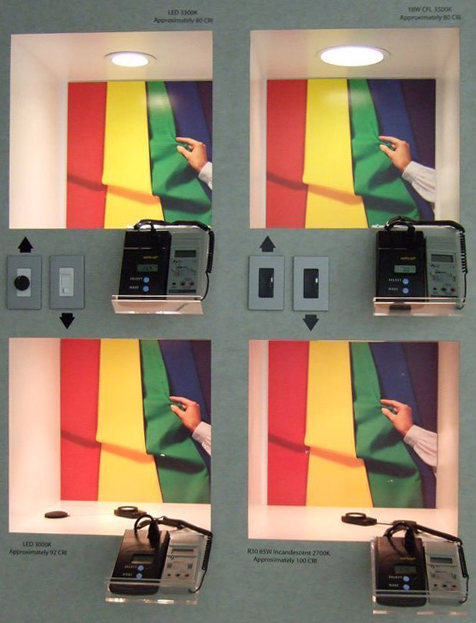 |
ESTABLISH DESIGN CRITERIA |
LIGHT AND COLOR
The color characteristics of a light source have an important influence on our perception of a space. It is important to consider the color temperature, CRI and spectral power distribution of a light source when designing interiors.
Color temperature
Color temperature describes how a lamp appears when lighted. It is expressed in Kelvin (K) [1]. All lamps have a color temperature assigned to them based on the color of light emitted.
This temperature is indicative of the temperature to which a theoretical blackbody radiator is heated such that its visible radiation matches the color of the light source.

Figure L-DC1. A photograph of various lamps illustrates the effect of color temperature differences (left to right) (1) Compact Fluorescent: General Electric, 13 watt, 6500 K (2) Incandescent: Sylvania 60-Watt Extra Soft White (3) Compact Fluorescent: Bright Effects, 15 watts, 2644 K (4) Compact Fluorescent: Sylvania, 14 watts, 3000 K. (Source: http://en.wikipedia.org/wiki/Image:CFBulbs.jpg).
CRI
The color rendering index is a numerical indicator of the color rendering capabilities of a light source compared to a full-spectrum source on a scale of 1 to 100. The reference for CRI changes with the color temperature of the light [2]. It is the average rendering performance of a given light source using eight test colors.

Figure L-DC2. The image shows how the rendering of colors in a scene change based on the color rendering index of the light source (Clockwise from top left) (1) LED 3300K approximately 90 CRI, (2) CFL 3500K approximately 80 CRI, (3) Incandescent 2700K approximately 100 CRI, and (4) LED 3000K approximately 92 CRI. (Source: Cooper Lighting Source Center.)
Spectral Distribution
The spectral distribution curve defines the relative color composition of a light source [3]. The spectral distribution of a light source can help one comprehend the reflection, absorption and transmission effects of light relative to a colored surface in addition to its CRI and color temperature.

Figure L-DC3. Spectral Power Distribution (left to right) (1) Typical Incandescent (2) SPX35 Tri-phosphor fluorescent, GE Lighting, (3) ConstantColor® Ceramic Metal Halide, GE Lighting. (Source: http://www.netl.doe.gov/ssl/usingLeds/general_illumination_color_basics.htm)
References




